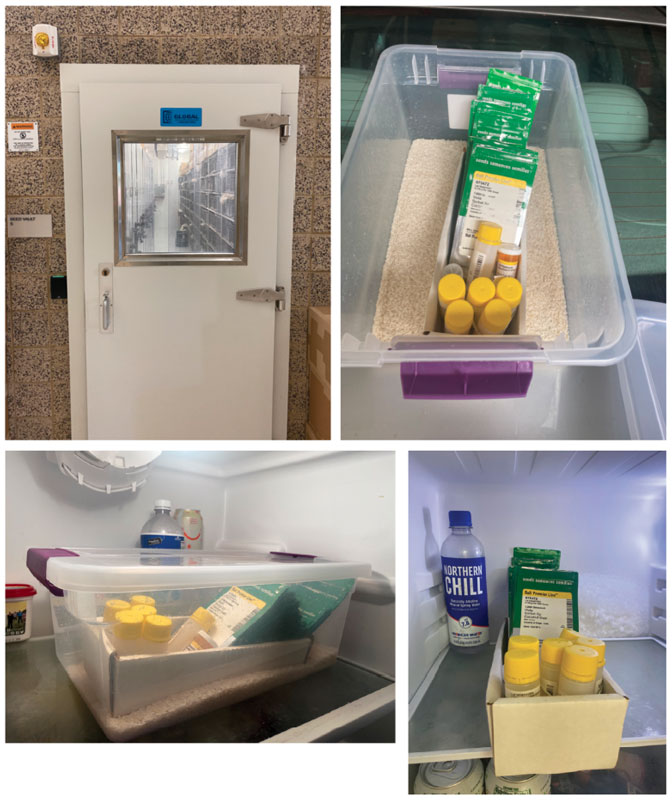11/1/2021
Keep Good Seeds From Going Bad
Jerry Gorchels

First of all, I want to start by saying that it’s best to use all the seed you purchase for the season. Carry-over seed isn’t a good practice for the best quality. Leave the seed storage issues to the breeder producers and seed distribution. They’ll have cyclical seed germ testing in place to make sure you get the best seed quality.
On this note, I would like to mention the importance of keeping records of the varieties you have, along with the corresponding lot or batch numbers. These records will make it so much easier to track any issues you may encounter.
Clockwise from far left: An industrial seed vault has a controlled relative humidity environment.
• To make it even more humidity controlled, line the bottom of the containers with an inch of uncooked rice.
• Many greenhouses store their seed in refrigerators.
• One option is to take the seed packets out of the boxes and store them in tightly seal containers with lock-tight lids.
Storage conditions
I also want to talk about all the different seed forms we work with now—pelleted, enhanced germ, coated, primed—to mention a few. These treatments and enhancements are done in a controlled environment where the air is balanced for optimal germ and storage.
There’s an easy equation a grower can follow for seed storage conditions. This involves temperature in Fahrenheit and the relative humidity percent. These two numbers should never add up to over 100. Ideally, the temperature for long-lasting seed storage should be 40F. The relative humidity should be between 25% and 40%. Higher relative humidity can cause faster degradation of the seed. Lower relative humidity can actually degrade the seed by drying it out. Remember: seed endosperm is a soft tissue that can dry out.
Now that we know the ranges and conditions of optimal seed storage, let’s look at the relationship of temperature and relative humidity. Depending on the temperature, air can hold more or less humidity. This is important to know when you’re trying to stay within optimal seed storage ranges.
For instance, warm air holds more humidity than cool air. A good example of this is when we purge humidity from the greenhouse going into the night. We warm up the air to hold more humidity, then vent it out before closing down the greenhouse for the day. With this in mind, seed packing rooms have controlled relative humidity. The air in the seed packets will be what it is when the packets are sealed. This factor is important when we’re talking seed storage.
Storage options
I’ve been in many greenhouses, head houses and sowing rooms in my lengthy career. Most of the large plug producers have controlled environment seed vaults where their seed inventory is kept. I’m not surprised when I see all the unique and innovative places where the sowing and seed storage is housed and kept in the rest of the grower community. When I inquire about the seed storage, the answer usually is, “We have a refrigerator.”
Let’s go back to the air temperature and relative humidity relationship … warm air holds more humidity, but when the air temperature drops that humidity is transferred into water in the form of condensation. This condensation can be detrimental to the quality of the seed storage. If the seed packets are sealed, this isn’t as critical. When the seed packets are opened and the unused seed is put back into the unregulated relative humidity storage, condensation will form in the seed packet, accelerating the degradation of the seed. This condensation can also cause issues when the seed is brought back out to sow; seed will stick together, pellets will crumble as they dry, etc.
I realize that it seems unrealistic for all businesses to have controlled environment seed vaults. Actually, a refrigerator can give us the temperature we need for optimal seed storage. What we must think about next is how we handle and control the unwanted humidity in the refrigerator. The seeds we receive are usually in cardboard boxes that line up very nicely on refrigerator shelves. One option is to take the seed packets out of the boxes and store them in tightly seal containers, i.e., Tupperware, craft storage containers with lock-tight lids, etc. This will remove the seed packets from the humidity in the refrigerator.
To make it even more humidity controlled, line the bottom of the containers with an inch of uncooked rice. What do we do when we drop our cell phones in water? We put them in the Ziploc baggy of rice. Change the rice out every couple months for continuous humidity control.
If you’re only purchasing seed for the season, much of this may not be an issue, depending how long or short your sowing season is. The demand for certain varieties has caused shortages in the greenhouse industry. Many growers are ordering early and taking ownership of the seed to ensure they have it. This can lengthen your seed storage situation.
Hopefully, this information can give you ideas on how and why you need to store your seed for optimal germination performance. Seed purchases are in investment—handle your investments wisely. GT
Jerry Gorchels is a Regional Account Manager for PanAmerican Seed.